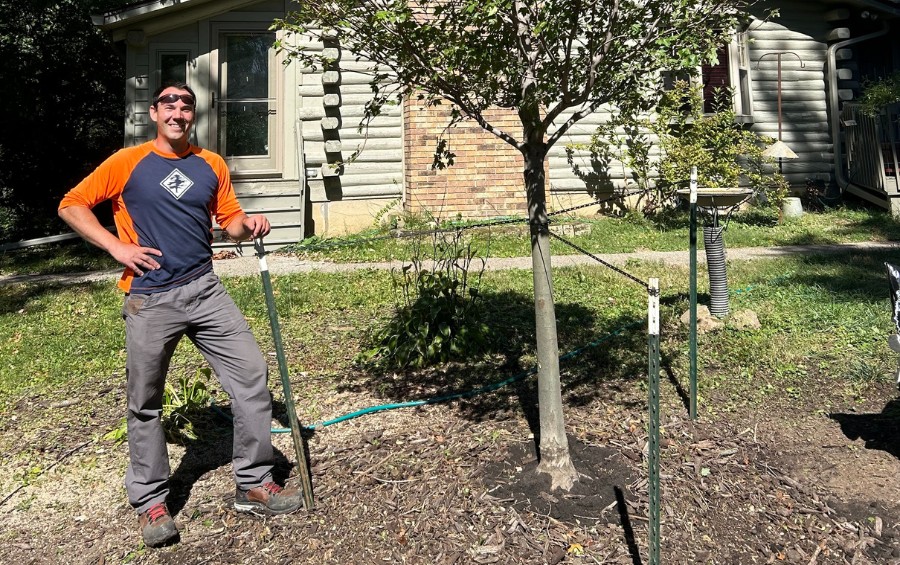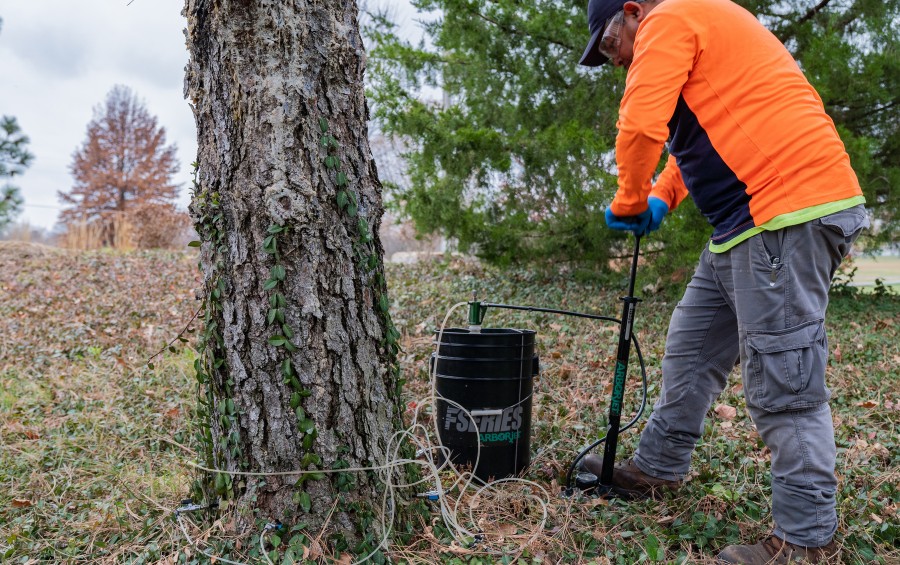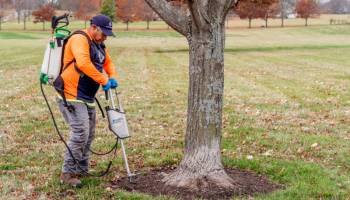6 Tips to Protect Your Tulsa Trees from Insects and Disease This Summer

Tulsa trees are under attack – protect yours. Explore smart, proactive ways to prevent insects and disease from weakening or killing your trees.
Ben Franklin famously said, “An ounce of prevention is worth a pound of cure.” And while he might not have been thinking about them at the time, his advice applies to your trees. In Tulsa, where insects and diseases can quickly take down even healthy trees, prevention is your best defense. Here’s what you can do to protect your trees before problems start.
Key Takeaways:
- Plant various tree species to prevent one insect or disease from wiping out your entire yard, since most pests typically target only specific tree species.
- Keep trees stress-free during summer by providing adequate water during droughts, mulching, and avoiding summer fertilization.
- Limit summer pruning to light, targeted cuts since pruning wounds create entry points for pests and pathogens when transmission rates are highest.
- Encourage beneficial insects like lady beetles and lacewings by maintaining various plants, as these natural predators help control harmful pest populations.
- Schedule regular tree inspections and work with ISA Certified Arborists for preventive treatments, as early detection and professional intervention are crucial for maintaining tree health.
6 Tips to Protect Your Trees from Insects and Diseases
With a little effort, you can give your trees the best chance to avoid an insect infestation or disease infection. Six things we recommend for your Tulsa trees to prevent insect and disease damage include:

1. Plant a Variety of Trees That Thrive in Tulsa
The first preventive measure you can take is a long-term one. While many of us have a favorite tree species or two, planting just one species of tree on your property not only makes it look a bit boring, but it can also open your property up to significant damage from insects and diseases.
Most insects and diseases only target specific species of trees. Take anthracnose as an example. This is a family of many similar fungal diseases. However, each member of the family typically only affects one species of tree. In short, oak anthracnose can’t infect a maple tree.
Planting a diverse range of trees prevents one disease or insect from wiping out your entire yard.
2. Keep Your Trees Free of Stress in the Summer
Insects and diseases are more likely to attack trees that are already stressed – especially during Oklahoma’s hot, dry summers. By reducing stressors like drought, heat stress, and nutrient deficiencies, you give your trees a better chance of resisting pests and staying healthy.
To help your trees stay strong when pests and diseases are most active, try these simple summer care tips:
- Water trees during a drought (we generally recommend 10 gallons of water per inch of trunk diameter)
- Place mulch around your tree to regulate soil temperature and increase nutrients in the soil
- Avoid summer fertilization that can lead to stress (save it for the fall)
- Prevent damage to the tree from construction or lawn care
3. Keep Summer Pruning Light and Targeted
Summer pruning can be helpful, especially for removing deadwood or thinning an overgrown canopy. But it should always be light and selective. Whether you do it yourself or hire a professional, focus on just a few branches, not major cuts.
Pruning helps trees, but it also creates wounds that give insects and fungi a way in. By making fewer cuts, you reduce the risk of pests and diseases, which is extremely important during peak transmission season.
If you want to do major trimming, consider waiting until winter when the tree is dormant and insects and diseases are inactive. Winter pruning also gives a tree time to compartmentalize and seal the wound to protect itself from further damage or decay.
PRO TIP: For more information about when and why to prune, read our seasonal pruning guide for Tulsa homeowners.

4. Introduce Beneficial Insects on Your Property
Not all insects attack your trees. In fact, most don’t. Introducing beneficial insects to your property can help keep pest populations down and make it easier to keep your trees healthier in Tulsa. While they won’t eliminate all pests, they can help control populations or prevent them from establishing in the first place. Some of the most common beneficial insects in Oklahoma include:
- Lady beetles
- Green lacewings
- Syrphid flies
- Damsel bugs
- Bigeyed bugs
“Don’t just go to the store, buy some insects, and let them loose in your yard, as you may be introducing non-native species. Instead, have a landscape full of various flowers and trees, and you should see more beneficial insects moving in to help you control the ones that are harmful to your trees. When in doubt, talk to an expert first.” – Scott Shipman, Plant Health Care Tech at Arbor Masters
5. Regularly Inspect Your Trees for Signs of Insect Damage or Disease Symptoms
Of course, all the attempts at prevention can only do so much, and you’re bound to have a sick tree or two on your property at some point, no matter what you do. In these instances, it’s always better to catch the problem early, rather than later, when the symptoms are more severe and the damage is greater.
Look for the common signs of a sick tree, including:
- Yellowing or discolored leaves
- Leaf damage from insects
- Early or premature leaf drop
- Damage or holes in the bark
- Increased insect activity around your trees
- Dead branches or patches in the canopy
- Discolored or dropping needles
When you see these signs in your trees, it’s a wake-up call to speak with an arborist. They can provide a more in-depth analysis, explain what is wrong with your trees, and devise a plan to fix the problem.

6. Have an Arborist Perform Preventive Treatments
You can supplement these natural methods with chemical treatments to give your trees the best chance to avoid any significant pest or disease problem. Preventive treatments will reduce the likelihood of insects establishing themselves on your property.
Preventive treatments include things like spraying and trunk injections. Trying to handle the application and timing of these treatments is nearly impossible for a homeowner. Instead, work with a professional company that employs ISA Certified Arborists, like Arbor Masters, who can use their expertise to determine how and the best time to apply the treatment to your trees.
Frequently Asked Questions About Preventing Tree Insects and Diseases
We understand that not every homeowner is aware of all the tree insects and diseases to watch out for every year. To help you better understand the importance of protecting your trees, we’ve answered some common questions to increase your knowledge about pests and diseases and the threat they pose to your trees.
What are some insects and diseases to watch out for in Tulsa?
Tulsa trees face threats from numerous insects and diseases, such as:
When should I be most aware of the signs of insects and diseases?
Each insect and disease has a different time that is most active. Further complicating matters is that the timing will change each season depending on the weather. In general, you’ll want to start looking for early signs of insects or diseases in the late spring and continue monitoring your trees throughout the summer.
Does an insect infestation or disease infection mean I will have to remove my tree?
No, an insect infestation or disease infection will not necessarily mean you have to remove your tree. Some pests and diseases are not life-threatening to your trees, and catching symptoms early can save a tree. Talk with an arborist when you notice the symptoms and have them determine your tree’s chance of survival.
Worried About Your Trees? Trust Tulsa’s Tree Experts at Arbor Masters
Even with all the preparation in the world, sometimes pests and diseases can still find a way in. If something looks off or you’re worried about a tree on your property, our certified team is ready to help with diagnosis and treatment.
We employ numerous ISA Certified Arborists who lend their expertise to every job we do. We’ll examine your trees, determine if they have a problem, and come up with a plan to treat them. Call us today at 918-258-3444 or request a quote online for help with insects and diseases.
Sorry, we couldn't find any posts. Please try a different search.

Get the latest local news, tree care tips, special offers, and company updates directly to your inbox! It's easy to subscribe and there's no spam - we promise.
"*" indicates required fields

